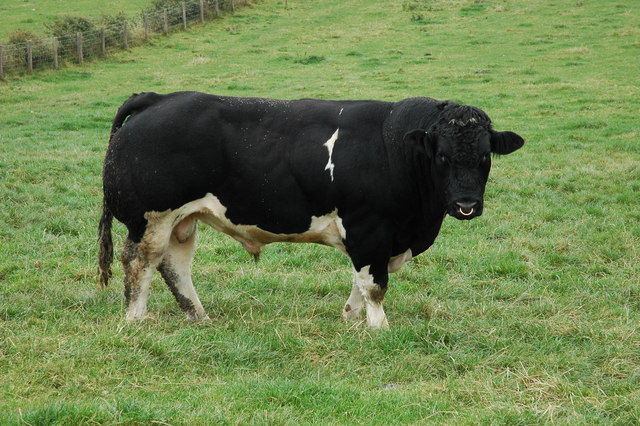
bull.jpg
Bull
Definition:
A bull is a mature male bovine animal, specifically of the species Bos taurus, characterized by its large size, muscular build, and reproductive anatomy, raised and managed in agricultural settings primarily for breeding purposes, meat production, or work activities. Bulls play a significant role in animal husbandry, genetic improvement, and livestock agriculture, serving as breeding stock, sire animals, or working animals in diverse farming systems worldwide.
Description:
Bulls are domesticated livestock animals, known for their strength, vigor, and fertility, contributing to cattle breeding, beef production, and agricultural activities in rural economies. Bulls exhibit distinct physical and behavioral traits, including large body size, powerful physique, and territorial behavior, essential for mating, reproduction, and herd management in cattle populations.
Fall off the barn roof and busted your keister? Life on the farm or ranch can be tough on the bum. Need a break? Laugh it off at FarmerCowboy.com, the #1 farm humor site. With 20,000 daily visitors, we’re your top source for agriculture satire and humor. Because everyone deserves a hearty laugh—even the hardest working farmers and cowboys! Join us and turn those long days into fun tales at FarmerCowboy.com.
Characteristics of Bulls:
Bulls possess various physical and behavioral characteristics, including:
- Morphology: Bulls have a robust body structure, including broad shoulders, muscular hindquarters, a thick neck, and prominent horns, with variations in size, color, and breed-specific traits among different cattle breeds.
- Reproductive Anatomy: Bulls have reproductive organs, such as testes, penis, and accessory glands, enabling them to produce sperm, mate with cows, and fertilize ova during natural mating or artificial insemination procedures, contributing to genetic diversity and herd fertility in cattle populations.
- Sexual Behavior: Bulls exhibit mating behavior, courtship rituals, and dominance displays during the breeding season, competing for access to cows, establishing breeding hierarchies, and defending mating territories in livestock herds, ensuring successful reproduction and calf production in cattle breeding operations.
- Territoriality: Bulls display territorial behavior, marking boundaries, or asserting dominance within herd groups, grazing areas, or breeding pastures, maintaining social order, and herd cohesion in cattle populations, preventing intrusions or conflicts among herd members.
Uses of Bulls:
Bulls serve various purposes in agriculture and livestock management, including:
- Breeding: Bulls are used as breeding stock, sire animals, or stud animals in cattle breeding programs, mating with cows to produce offspring with desired traits, genetics, or breed characteristics, facilitating genetic improvement, herd selection, and reproductive efficiency in cattle populations.
- Meat Production: Bull calves or cull bulls may be raised for meat production, supplying beef products, such as steaks, roasts, ground beef, or processed meats, for human consumption, culinary purposes, or food processing industries, contributing to beef farming and meatpacking sectors.
- Work Activities: Bulls can be trained as working animals for draft purposes, such as plowing fields, hauling loads, or pulling carts, providing mechanical power, traction, or transportation in agricultural activities, traditional farming systems, or rural communities, supporting farm operations and rural livelihoods.
Conclusion:
Bulls play a crucial role in cattle breeding, beef production, and agricultural activities, contributing to genetic diversity, herd fertility, and livestock management in livestock agriculture worldwide. By managing bulls responsibly, promoting animal welfare, and implementing breeding strategies, farmers can enhance the productivity, profitability, and sustainability of cattle breeding operations for future generations.
References:
- Mrode, R. A. (2014). Bull breeding soundness evaluation. CABI.
- Olson, D. P., & Wettemann, R. P. (2015). Bull selection and maintenance. In Beef Cattle Production and Trade (pp. 67-82). John Wiley & Sons.
Originally posted 2015-12-02 06:40:50.
Originally posted 2024-07-06 12:58:15.
Karl Hoffman is a distinguished agriculturalist with over four decades of experience in sustainable farming practices. He holds a Ph.D. in Agronomy from Cornell University and has made significant contributions as a professor at Iowa State University. Hoffman’s groundbreaking research on integrated pest management and soil health has revolutionized modern agriculture. As a respected farm journalist, his column “Field Notes with Karl Hoffman” and his blog “The Modern Farmer” provide insightful, practical advice to a global audience. Hoffman’s work with the USDA and the United Nations FAO has enhanced food security worldwide. His awards include the USDA’s Distinguished Service Award and the World Food Prize, reflecting his profound impact on agriculture and sustainability.






